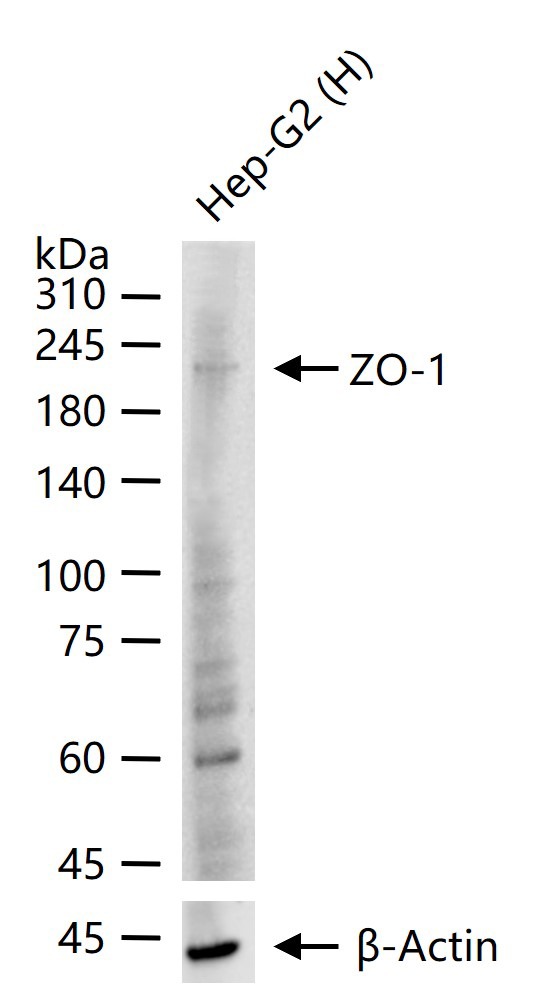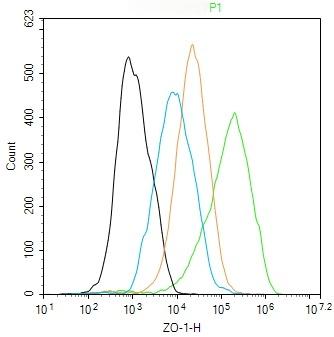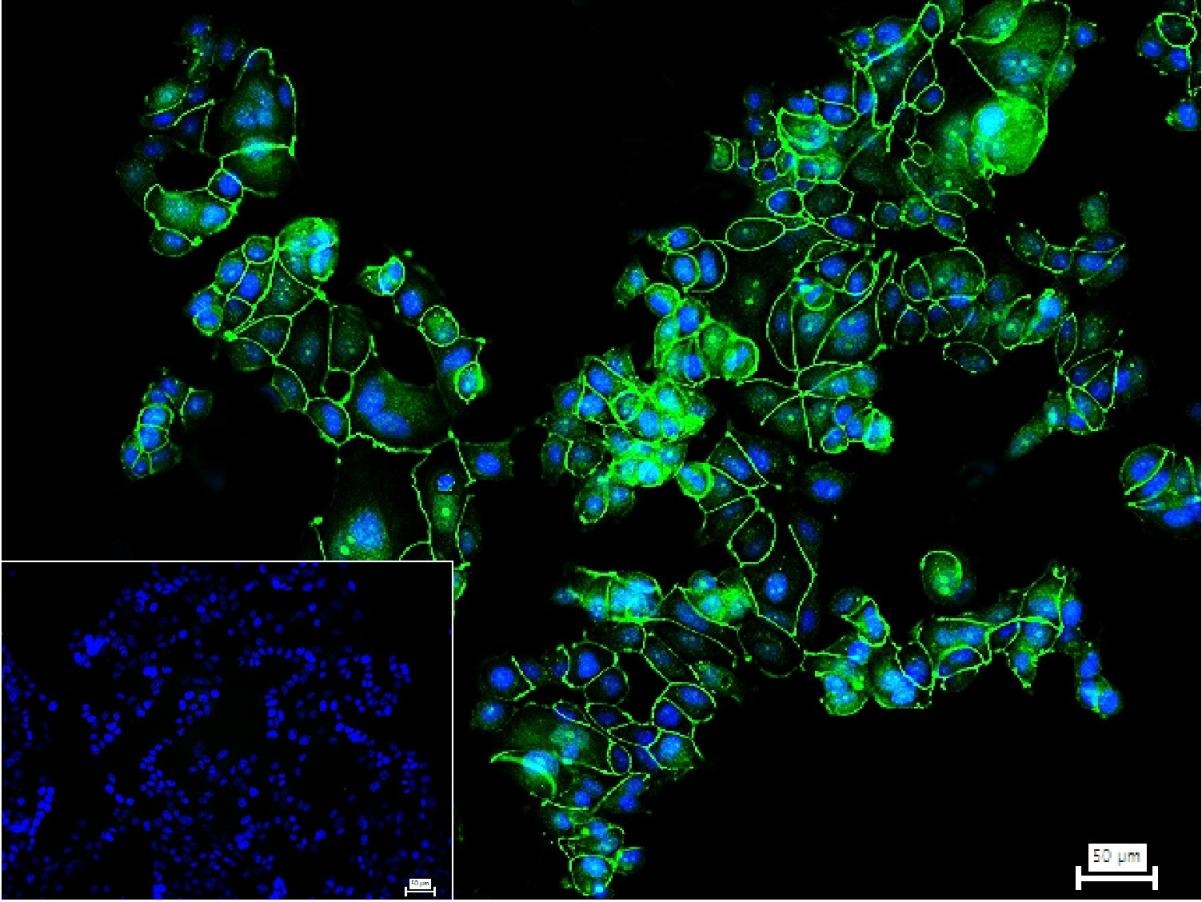Shopping Cart
- Remove All
 Your shopping cart is currently empty
Your shopping cart is currently empty
Anti-ZO-1/TJP1 Polyclonal Antibody 2 is a Rabbit antibody targeting ZO-1/TJP1. Anti-ZO-1/TJP1 Polyclonal Antibody 2 can be used in FCM,ICC/IF,WB.
| Pack Size | Price | Availability | Quantity |
|---|---|---|---|
| 50 μL | $222 | 7-10 days | |
| 100 μL | $373 | 7-10 days | |
| 200 μL | $528 | 7-10 days |
| Description | Anti-ZO-1/TJP1 Polyclonal Antibody 2 is a Rabbit antibody targeting ZO-1/TJP1. Anti-ZO-1/TJP1 Polyclonal Antibody 2 can be used in FCM,ICC/IF,WB. |
| Synonyms | Zonula occludens protein 1, Zona occludens protein 1, ZO1, TJP1, Tight junction protein ZO-1, Tight junction protein 1 |
| Ig Type | IgG |
| Reactivity | Human |
| Verified Activity | 1. 25 μg total protein per Lane of various lysates probed with ZO-1 polyclonal antibody, unconjugated (TMAB-01999) at 1:1000 dilution and 4°C overnight incubation. Followed by conjugated secondary antibody incubation at RT for 60 min. 2. The MCF-7 (H) cells were incubated in 5% BSA to block non-specific protein-protein interactions (30 min at room temperature). Primary Antibody (green): Rabbit Anti-ZO-1 antibody (TMAB-01999): 1 μg/10^6 cells; Secondary Antibody (white blue): Goat anti-Rabbit IgG-BF488: 1 μg/test. Isotype Control (orange): Rabbit IgG. Blank control (black): PBS. 3. The MCF-7 (H) cells were incubated in 5% BSA to block non-specific protein-protein interactions (30 min at room temperature). Primary Antibody (green): Rabbit Anti-ZO-1 antibody (TMAB-01999): 1 μg/10^6 cells; Secondary Antibody (white blue): Goat anti-Rabbit IgG-BF488: 1 μg/test. Isotype Control (orange): Rabbit IgG. Blank control (black): PBS.    |
| Application | |
| Recommended Dose | WB: 1:500-2000; ICC/IF: 1:50-200; FCM: 1μg/Test |
| Antibody Type | Polyclonal |
| Host Species | Rabbit |
| Subcellular Localization | Cell membrane; Peripheral membrane protein; Cytoplasmic side. Cell junction, tight junction. Cell junction. Cell junction, gap junction. Note=Moves from the cytoplasm to the cell membrane concurrently with cell-cell contact. Detected at the leading edge of migrating and wounded cells. |
| Tissue Specificity | The alpha-containing isoform is found in most epithelial cell junctions. The short isoform is found both in endothelial cells and the highly specialized epithelial junctions of renal glomeruli and Sertoli cells of the seminiferous tubules. |
| Construction | Polyclonal Antibody |
| Purification | Protein A purified |
| Appearance | Liquid |
| Formulation | 0.01M TBS (pH7.4) with 1% BSA, 0.02% Proclin300 and 50% Glycerol. |
| Concentration | 1 mg/mL |
| Research Background | This gene encodes a member of the membrane-associated guanylate kinase (MAGUK) family of proteins, and acts as a tight junction adaptor protein that also regulates adherens junctions. Tight junctions regulate the movement of ions and macromolecules between endothelial and epithelial cells. The multidomain structure of this scaffold protein, including a postsynaptic density 95/disc-large/zona occludens (PDZ) domain, a Src homology (SH3) domain, a guanylate kinase (GuK) domain and unique (U) motifs all help to co-ordinate binding of transmembrane proteins, cytosolic proteins, and F-actin, which are required for tight junction function. Alternative splicing results in multiple transcript variants encoding different isoforms. [provided by RefSeq, Aug 2017] |
| Immunogen | KLH conjugated synthetic peptide: human ZO-1 |
| Antigen Species | Human |
| Gene Name | TJP1 |
| Gene ID | |
| Protein Name | Tight junction protein ZO-1 |
| Uniprot ID | |
| Biology Area | Plasma Membrane |
| Function | The N-terminal may be involved in transducing a signal required for tight junction assembly, while the C-terminal may have specific properties of tight junctions. The alpha domain might be involved in stabilizing junctions. Plays a role in the regulation of cell migration by targeting CDC42BPB to the leading edge of migrating cells. |
| Molecular Weight | Theoretical: 191 kDa. |
| Stability & Storage | Store at -20°C or -80°C for 12 months. Avoid repeated freeze-thaw cycles. |
| Transport | Shipping with blue ice. |

Copyright © 2015-2025 TargetMol Chemicals Inc. All Rights Reserved.